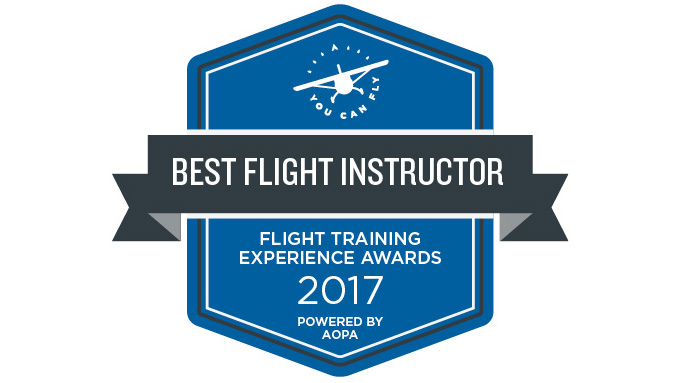The CFI's CFI
Creating excellence in the industry
 If Zoan Harclerode had gained admission to the United States Air Force Academy in the 1970s, you most likely would not be reading about her in this magazine.
If Zoan Harclerode had gained admission to the United States Air Force Academy in the 1970s, you most likely would not be reading about her in this magazine.

The academy had just begun to accept women. But Harclerode wore corrective lenses, and Air Force pilots did not wear glasses. And Harclerode’s father—a high school guidance counselor who “almost never said no”—strongly advised her against applying.
A few decades later, the Kansas City, Missouri, native teaches people to fly in Colorado Springs, Colorado—practically in the shadow of the institution where she had once hoped to earn her wings. A dedication to instilling students with the highest standards earned Harclerode the designation of 2017 Best Flight Instructor in the AOPA Flight Training Experience Awards.
“That’s her key attribute is how she motivates folks,” said John Maier, a CFI whom Zarclerode helped to return to flight instructing after a long hiatus. “She’s motivated in what she does, and that’s what rubs off on folks.”
Harclerode is an assistant chief flight instructor at Rocky Mountain Flight Training Center at Peterson Air Force Base in Colorado. The club was voted a Distinguished Flight School in the 2017 Flight Training Experience Awards (see p. 40). If you’re an active or retired member of the military, a dependent of military personnel, a military contractor, or a member of the Civil Air Patrol, you can join the club and train with Harclerode, who has been with the club since 2009.
And if, like Genevieve Zasada Anonsen, you learn to fly with Harclerode—you gain not only a skilled teacher, but also a staunch advocate who can envision your aviation goals while you are still grappling with them.
Anonsen trained with Harclerode from private pilot through her flight instructor certificate. Anonsen recently completed officer training school for the U.S. Air Force. In the midst of her pilot training she applied for scholarships to help fund flight training. One application came close to being rejected.
“The trustee board told her I could always apply next year,” Anonsen said. “She responded with, ‘No she can’t, she’ll be flying for the Air Force by then!’
“That was an emotional moment for me as a new flight student,” Anonsen said. “I had not yet applied, had not yet been accepted, nor had I internalized the thought of becoming an Air Force pilot outside of the fantasy I had told her, but here she was advocating for me like it was going to happen tomorrow. That’s the kind of instructor and mentor Zoan is.”
Hatching new flight instructors
Harclerode credited the ability to do different things with helping to keep flight instruction fun and challenging. These include mountain flying and the occasional Part 135 second-in-command gig in a Cessna CitationJet. She particularly enjoys training new flight instructors, and said she learns a lot from each candidate.
In return, Harclerode passes along 30 years worth of aviation experience (see “The Winding Road”). “She’s extremely patient, which is good for somebody like me, an older person who doesn’t have the same retention skills” as a younger pilot, said Tom MacDonald, who worked with Harclerode to become a CFI. “She’s an excellent pilot as well, which doesn’t hurt when you’re dealing with gusty wind conditions and the challenging environment of crosswinds at Colorado Springs.”
MacDonald said he hopes to emulate Harclerode’s zeal in his own flight instruction. “She’s excited to see every single student, no matter who the person is,” he said. “She is engaged with people to an incredible degree.” He is now a part-time flight instructor with the Rocky Mountain Flight Training Center, and said it’s a treat to be able to pass on Harclerode’s wisdom to his students.
Start with the simple
When working with a student pilot, Harclerode said, it’s important to realize that “people learn things more starting from the simple and moving into the complex, starting from someplace they know.” When discussing propeller blade angles, for example, she’ll compare the way a lower rpm takes a bigger bite of air to a swimmer who can go farther with long strokes.
Her goal is to give pilots a frame of reference they can build on as they become more familiar with the aircraft’s systems.
“We can never teach our pilots to deal with all the emergencies and urgenices they might encounter, but if we can teach them about the systems and [how] the different parts of the aircraft work and interact with each other, maybe when they have some urgency they’ll have a framework, some boxes to put this stuff in,” Harclerode said.
She urges other flight instructors to encourage their students to make good choices. At the same time, students should be allowed to make mistakes, “because they learn best when they make mistakes,” she said. “On the other hand, you might have to take [the controls] too soon because if you take it too late, that is so much your fault.”
Anyone can learn to fly, “but they have to put their heart into it,” Harclerode said. “It’s tough to be a pilot,” she said. “It’s not really a bucket-list thing. You wouldn’t go to a dentist and say ‘Hey, I want to learn to fill cavities’” as a bucket-list goal.
“To welcome someone who goes through the trouble to do all the tests and training and get the skill and knowledge…that’s exciting.”

 Zoan Harclerode (left), shown with Diane Gillings, “is passionate about flying and it shows every time you work with her,” said former colleague Ed Helmick.
Zoan Harclerode (left), shown with Diane Gillings, “is passionate about flying and it shows every time you work with her,” said former colleague Ed Helmick. 